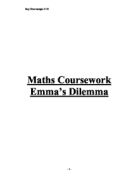From this table I can see a pattern that if you multiply the number of arrangements by the number of letters in that arrangement plus 1 letter, you can get the next number of arrangements.
For example:
2(different arrangements) x 3(number of letters)
This will equal 6, the next arrangement.
From this method I can work out the next arrangements. I have drawn up another table but with more arrangements.
But I have found a far easier way of working this out. Instead of using the method before I can use a method called a FACTORIAL PRODUCT. This is where if I wanted to work out the number of arrangements in a 6 lettered word (providing all the letters are different) I could do a simple calculation:
1x2x3x4x5x6 = 720
This is the number of arrangements for a 6 lettered word.
This can be written as 6! (! = Factorial Product)
So the formula for this is n! =a
.n= the number of letters.
.a= the different number of arrangements for n.
So:
8! =40320
10! =3628800
12! =479001600
The way I got this from the first method to the second method is by this:
To get the amount of arrangements for a 4 lettered word it would be 6x4, but to get the 6, you need the calculation for the arrangement before which was 1x2x3.
So I then substituted the answer for the calculation which was then:
6 x 4 = 24 6 = answer
Substituted 1 x 2 x 3 = Calculation
1 x 2 x 3 x 4 = 24
So it is still the same calculation as before except I have changed the answer with the calculation.
This works the same for the next one,
For a word with 5 letters, to get the amount of arrangements before it would be:
24 x 5
But to get the 24 you would need to do 6 x 4 or 1 x 2 x 3 x 4.
So for this calculation it would be:
1 x 2 x 3 x 4 x 5 = 120
Now I am going to try to find all the different arrangements of the letters in a word with 2 of the letters being the same.
There are 4 letters, 2 being the same and there are 12 different arrangements.
There are 3 letters, 2 being the same and there are only 3 different arrangements.
BB
There are only 2 letters the same and there are 1 arrangements.
I have drawn up a results table showing my results of no letters repeated and the same letter repeated twice.
I have found a relationship between no letters repeated and the same letter repeated twice, this is that the same letter repeated twice is exactly half the amount for no letters repeated.
If you imagine that the 2 m’s are different in the name Emma you will get 24 arrangements. But if you pair up all the arrangements that are the same you end up with half the full amount, which is 12. This is shown below.
There are 24 arrangements. I have labelled up the arrangements so that I can tell which ones pair up to make one arrangement.
So all the 1’s pair up, all the 2’s pair up and so on. This is because each pair are the same arrangement.
EMMA
Same arrangement EMMA make one arrangement
EMMA
I have done this to all the arrangements in the word EMMA. These are the arrangements.
This is half the amount of all the 24 so the 24 have been halved to equal the number of arrangements for a 4 lettered word with 2 letters the same.
This works the same with any other amount of letters in a word with 2 letters the same.
24 / 2 = 12
4! / 2 = 12
So the formula for this is: n! / 2
I have drawn up a table with all the number of arrangements for the same letter repeated twice.
Now I’m going to find out all the different arrangements for a word with 3 letters the same.
CCC
A 3 lettered word with 3 letters the same, there is only 1 arrangement possible.
CCCA
CCAC
CACC
ACCC
A 4 lettered word with 3 letters the same there are 4 different arrangements.
A 5 lettered word with 3 letters being the same there are 20 arrangements.
But if I make all the C’s different I get 24 arrangements. But if I pair up all the arrangements that are the same, as before, I only get 4 arrangements.
So if I put all the 1’s together, all the 2’s together, all the 3’s together and all the 4’s together, I get 4 arrangements.
CCCA
CCAC
CACC
ACCC
Now I am left with the 4 of the original 24 arrangements so the formula for this would be,
.n! / 6
It is divided by 6 because there was six of the same arrangements. For example the ACCC was repeated 6 times by,
ACCC
ACCC
ACCC n! / 6
ACCC
ACCC
ACCC
It is also six because in a 3 lettered word you can only get 6 different arrangements, and towork out the six you do 3! So the formula can now be
n! / 3! = a
So now I have found an overall formula:
n! /x! = a
n = the number of letters
x = the number of letters repeated for n
a = the different number of arrangements.
This works because for a 4 lettered word with 3 letters the same repeated it would be:
4! / 3! = 4
And it also works for an 8 lettered word with 2 letters repeated:
8! / 2! = 20160
This shows that my theory works.







